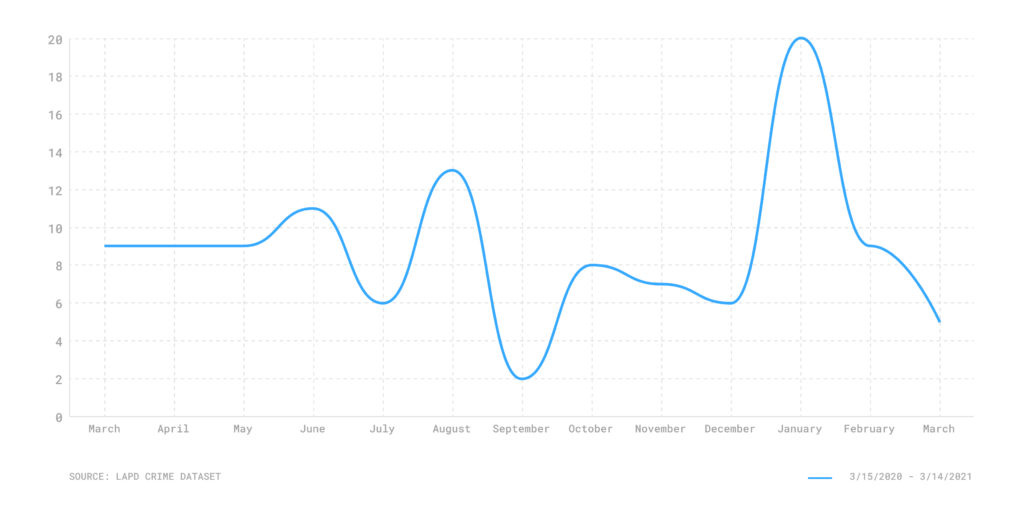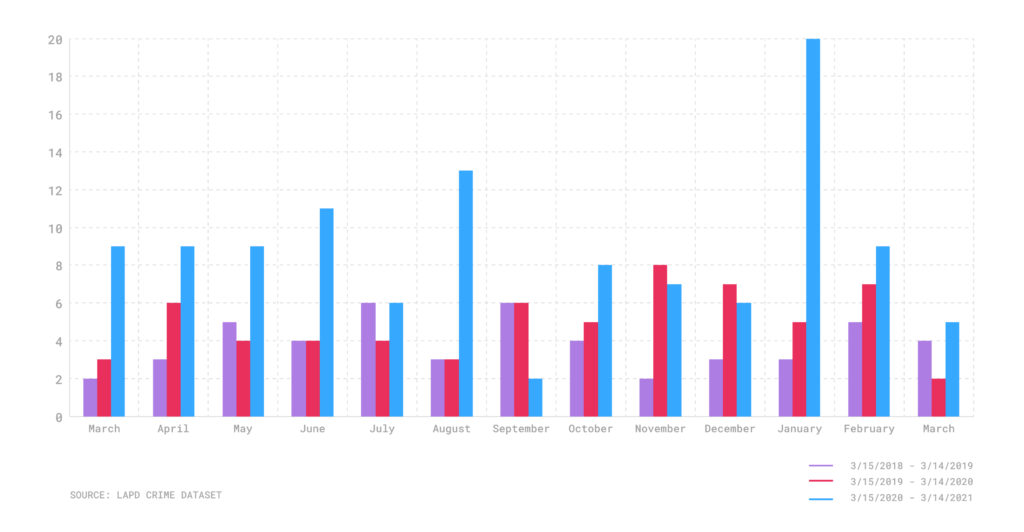For drivers, deliveries can bring danger

Last spring, businesses across Los Angeles shut down due to the emerging threat of the novel coronavirus. With uncertainty and sometimes even fear over going out, Angelenos began ordering in, seeking safe delivery of meals, groceries and more. Amazon trucks seemed ever-present.
While delivery businesses saw a surge in activity, there was one uncomfortable asterisk: crimes against delivery drivers spiked.
From March 15, 2020 (when Mayor Eric Garcetti ordered the cessation of in-person service at Los Angeles bars and restaurants) through March 14, 2021, there were 114 crimes against delivery people, according to Los Angeles Police Department data. That represents a 78% rise over the 64 incidents in the previous 12-month period.
Annual crimes committed against delivery people

This came even as overall crime in Los Angeles in that same timeframe fell by 12%, according to the LAPD.
The number of incidents in the pandemic year is a 128% increase over the 50 crimes perpetrated against delivery workers from March 15, 2018-March 14, 2019.
There was little month-to-month consistency in the past year. There were 20 crimes against delivery workers in January 2021, but only two last September.
Crimes against delivery people by month in the pandemic year

Delivery people are not the only ones who increasingly became targets of criminals. In the last year, there has been a 200% increase in crimes against United States Postal Service employees, according to the LAPD.
Since the start of the pandemic, people have become more reliant on online orders, and delivery services such as Grubhub, DoorDash and UberEats have seen skyrocketing sales. That has led to a demand for delivery workers.
While this has been a bright spot in a difficult economy, these employees also face a higher risk of exposure to COVID-19 by virtue of crossing paths with so many other people.
Common crime types
From March 15, 2020-March 14, 2021, there were 36 reported robberies of a delivery person in Los Angeles, according to LAPD data. That made it the most frequent crime against delivery workers, surpassing the 29 assaults.
A spokesperson for Uber said the company has seen an increase in carjacking and other violent assaults against its drivers during the pandemic, though they did not share specific numbers for Los Angeles.
In a statement provided to Crosstown, a Grubhub representative said the company advises drivers and couriers to exercise extreme caution when delivering orders. Grubhub will regularly send in-app notifications about safety practices to drivers, the spokesperson said, and give them the option to reject an order, without a penalty, if they feel uncomfortable completing a delivery.
If injured on the job, a driver can contact a company representative who will work with the person and law enforcement officials.
A spokesperson for DoorDash also stressed that safety is paramount, and said that later this year the company plans to integrate an in-app emergency assistance button for drivers to easily connect with emergency services.
Monthly crimes committed against delivery workers, 2018-2021

According to the LAPD, the neighborhood of Vermont Knolls recorded seven attacks in the pandemic year, the most of any Los Angeles neighborhood. This includes the carjacking on June 10 of a 46-year-old delivery person.
Historic South-Central, Sylmar and University Park each were the site of five attacks against delivery workers during the pandemic year.
How we did it: We examined publicly available LAPD data on reported crimes in the city of Los Angeles, and reported crimes from the Los Angeles Sheriff’s Department. LAPD data only reflects crimes that are reported to the department, not how many crimes actually occurred. In making our calculations, we rely on the data the LAPD makes publicly available.
The LAPD periodically updates past crime reports with new information, leading the department to recategorize past reports. Additionally, revised reports do not always automatically become part of the public database.
Want to know how your neighborhood fares? Or simply just interested in our data? Email us at askus@xtown.la.






